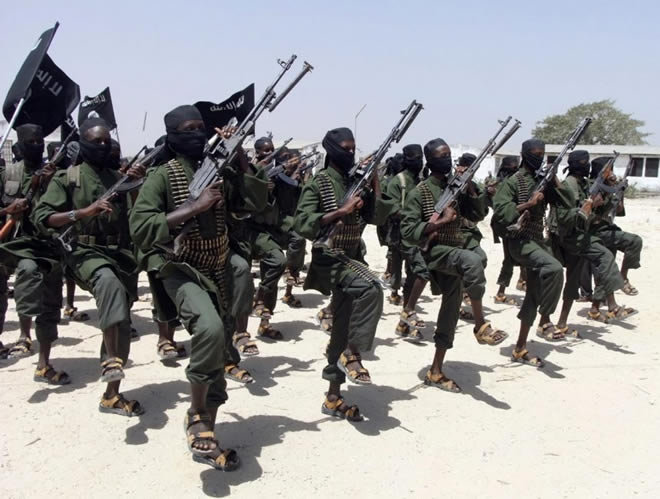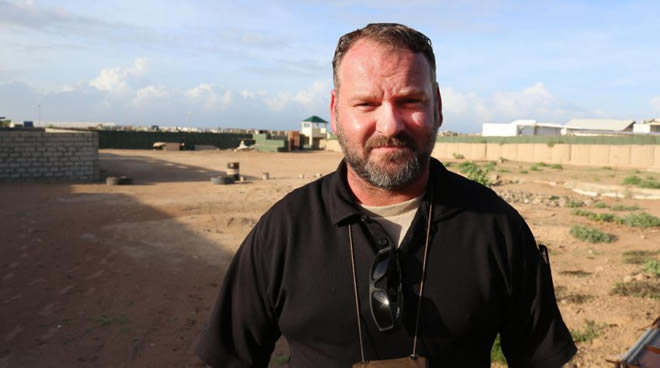
Sunday, June 26, 2016
By MICHELLE SHEPHARD
For the first time, a journalist gets access to the Mogadishu camp where about 500 former Somali Shabab members are being held. Part of the Atkinson Fellowship's Generation 9/11 series.

Somalia’s amnesty program allows former Shabab members to surrender without prosecution. With the Shabab’s popularity waning, there have been hundreds of Somalis who have also left and are now being housed and counselled in “disengagement” camps in the capital and throughout the country. (FARAH ABDI WARSAMEH / AP)
MOGADISHU, SOMALIA—The 30-year-old sitting in the home of Somalia’s Minister of Internal Security is a wanted man. There is a U.S. warrant for his arrest and a $50,000 reward for information leading to his capture and conviction.
Liban Haji Mohamed is charged with providing material support and resources to Al Shabab, Al Qaeda’s East Africa branch. If he went home to northern Virginia and was found guilty, chances are he would spend many years in jail.
Which is why he says he is never leaving Somalia. And the Somali government is not going to force him.
“I believe people should have an option in life. If you make your mistake, accept your mistake, leave this behaviour,” Mohamed tells me. “The government still keeps track of you. Our communications are monitored. We’re not engaged in any illegal activities. If I was, the CIA would pick me up in one second.” He snaps his fingers.
Mohamed is part of Somalia’s amnesty program, which allows former Shabab members to surrender without prosecution. He is one of a handful of foreign members who have defected — men and women of Somali heritage who grew up Europe, Australia, or the U.S.
The majority of foreigners who joined the Shabab were in their 20s, coming of age in the aftermath of the Sept. 11, 2001, attacks. The Shabab’s Western members were among the first of Generation 9/11 to join a foreign terrorist group — a problem that increased dramatically in the last few years with the Syrian war and creation of Daesh, the group also known as ISIS and ISIL.
With the Shabab’s popularity waning, there have been hundreds of Somalis who have also left and are now being housed and counselled in “disengagement” camps in the capital and throughout the country.
Somalia’s amnesty program has been operating for more than four years and the government has given diplomats and journalists tours of the camp that operates in Baidoa, about 240 kilometres northwest of the capital.
But for the first time last month, officials revealed that there are foreign members like Mohamed, who have defected and are living in Mogadishu. They also escorted me on a visit to the secret camp in the capital, where about 500 former Somali Shabab members are being held — the first time a journalist has been inside.
No Canadians have officially sought amnesty, but security officials know that two former members from Toronto are living quietly in Somaliland, a semi-independent state north of Mogadishu. They too were reportedly fed up with the Shabab and escaped. For those who defect but do not have Somali citizenship, the government works with foreign partners to deport them — at least one has quietly returned to Europe.
But since Somalia does not have extradition agreements with Western countries, the government is not legally bound to hand over dual citizens who also hold Somali passports, as Mohamed does.
Instead, in the 18 months since he has defected, Mohamed has been working with the government to counter Shabab’s false stories online and counselling others to leave, weakening their forces one defector at a time.
It is difficult to compare Somalia, which has been in turmoil for more than two decades, plagued by internal corruption and external meddling, to almost anywhere else.
But the questions that have been asked about Al Shabab for years here — How to counter the Al Qaeda narrative? How should defectors be handled? Can terrorists “disengage?” Can they be “rehabilitated?” — are now being asked worldwide with the rise of Daesh in Syria and Iraq.

Abdirizak Omar Mohamed, Somalia's Minister of Internal Security, speaks with an Shabab defector inside a "disengagement" camp for low-risk former members of the Al Qaeda group. Mohamed, a Canadian who used to work with the housing department at the City of Toronto, says he feels the government must use "soft approaches" to fight terrorism in addition to military, police and intelligence measures. (TORONTO STAR)
Minister Abdirizak Omar Mohamed (no relation to Mohamed), a Canadian who once worked for the City of Toronto’s housing department before returning here in 2012, believes governments worldwide need to look beyond just throwing people in jail. “You have to use a soft approach, too, you have to open dialogue with them, engage them and you have to provide a counter-narrative to the ideology,” he said.
“It’s not the solution, but it’s one of the solutions.”
The program has its skeptics and there is reason for concern.
The Washington Post reported in April some defectors as young as 10 had been exploited by Somalia’s intelligence agency and used as Shabab informants. While the faces of the intelligence agents were concealed, the boys were rarely covered. Some were allegedly killed and one tried to hang himself while in custody.
Somalia’s prime minister called an investigation after the story broke, but few dispute the claims — the abuse was a poorly kept secret.
Minister Mohamed said the program did undergo a major overhaul after he was appointed in February 2015. All underage defectors were moved to the Elman Peace and Human Rights Centre, operated by Canadian Ilwad Elman and her mother, Fartuun Adan, by the end of the year.
Another concern for the program — for both foreign and local defectors — is one of security. The Shabab’s popularity may be at an all-time low, but they still control areas in the south and have infiltrated the capital. For example, the female suicide bomber of a recent hotel attack had worked there for months before blowing herself up.
The minister says defectors are carefully screened and negotiations can sometimes take months. Only those considered low-risk are allowed into the program, while high-risk former members are prosecuted.
One of the minister’s allies is former U.S. Navy Seals commando Robert Kaneiss, who began working as a security consultant for the disengagement program here 10 months ago because, as he says, he became “so tired of firearms and guns and fighting.”
“I had my doubts given my own perception of what’s going to happen with terrorism,” says Kaneiss. “(But) when you actually see it and experience it on the ground, you can’t help but want to be a part of what this could be if it succeeds.”
Mohamed’s journey from a fairly typical high-school student to supporter of one of the world’s most brutal terrorist groups is not unlike those of other westerners who joined Al Shabab.
For many, it began when the group rose to power in late 2006. Al Shabab were known as nationalists, opposed to the U.S.-backed Ethiopian invasion. The leadership included some who had ties to Al Qaeda, but the majority of foot soldiers joined to protect Somalia’s independence, not because they were driven by ideology.
When Ethiopia was pushed out by 2009, many moved on.
But Mohamed, who was born in Somalia but immigrated to the U.S. with his family when he was young, remained curious. From his home in northern Virginia, he began watching the online preaching of U.S.-born Yemeni Anwar al Awlaki, who spoke convincingly to westerners about the duty of “jihad.”
Then, in 2010, three important events occurred in Mohamed’s life.
His younger brother, Gulet, who was 18, was arrested in Kuwait. In a telephone interview on a cell phone smuggled into the prison, Gulet told the New York Times’ Mark Mazzetti and journalist Glenn Greenwald that he was being severely beaten. FBI agents, he said, also questioned him about Awlaki and a trip he had made to Yemen. “(He) said the FBI agents interrogated him even after he refused to answer their questions without a lawyer, and after they gave him a paper listing his Miranda rights,” Mazzetti reported in January 2011.
A few weeks later, Kuwaiti officials cleared him for deportation but Gulet could not be flown home because he was on the U.S. no-fly list. Eventually, the U.S. issued a one-time waiver, allowing him to board a plane. According to his brother, Gulet returned home devastated. He sued the U.S. government and last year a federal judge ruled that his inclusion on the no-fly list breached his constitutional rights.
Around the same time in 2010, Mohamed’s 21-year-old friend Zachary Adam Chesser was sentenced to 25 years in jail for providing material support to the Shabab. He admitted to threatening the creators of South Park in an online post and operating a radical website. He pleaded guilty and pledged to co-operate with authorities.
Mohamed said while Chesser had become “quickly radicalized,” he felt the FBI duped him and the sentence didn’t reflect the crime. “The FBI told him to confess and then as soon as he confessed they indicted him.”
By 2012, Mohamed was on the FBI’s radar and he was also included on the no-fly list. The only work he could get was driving a cab.
“I just think if they had left me alone I would have been OK,” he says. “At the time, I couldn’t fly, I might as well finish my school and work. That was my intended goal. But it didn’t work out like that because the level of harassment was just too much, cars following you. Random, stupid people they send. I mean, the money they waste.”
Al Shabab’s power became alluring he said at a time when he felt helpless. The harder the FBI pushed, the stronger the group’s pull became.
The FBI’s case against Mohamed is unknown as the indictment remains sealed. The Most Wanted poster alleges that he provided “material support” to the Shabab and while living in northern Virginia “was a recruiter and radicalizer” for the group.
A lawyer for Mohamed’s family questioned the timing of the January 2015 FBI release since it was the day before a crucial hearing in his brother Gulet’s lawsuit.
The Somali government found it curious too, since according to the minister and senior officials here, Mohamed had turned himself in by January and was co-operating with government officials when the FBI publicized his case.
In March 2015, various U.S. news outlets quoted unnamed U.S. officials saying that Mohamed had been apprehended after the FBI notice. “It was just not true,” said one official here who helped convince Mohamed to defect. “He had already been working with us.”
Mohamed admits now that while in the U.S. he did work as an administrator of two Al Shabab websites, posting what was sent from contacts in Somalia. “I would write something and then the Associated Press would quote it, or something,” he says. When a Canadian fighter known as “Canlish” was killed, Mohamed said he wrote glowingly of his martyrdom in an online post.
He eventually left for Mogadishu in July 2012, managing to elude authorities by crossing first into Mexico.
After arriving in Mogadishu, Mohamed travelled south and joined Al Shabab. They were ignorant and dictatorial, nothing like their online persona, he says. Within two days he was arguing with senior members and five weeks later, as he was in the process of officially pledging allegiance, he claims he was thrown in a Shabab jail, accused of being a spy.
In jail, he says he was abused, along with other foreign members, and he grew bitter.
By 2013, the Shabab’s leadership was suspicious of most of the foreigners and since Mohamed’s uncle had been killed by the Shabab, they worried he was a U.S. agent. Omar Hammami, an Alabama propagandist who went by the kunya, or nickname, Abu Mansoor Al Amriki, had turned against the group and publicly criticized them. He was assassinated. Mohamed said someone in Shabab’s intelligence unit told him, “I don’t want to see any more foreign fighters from the West. If they do come here, I’m gonna take them to the mountains in Golis (in northern Somalia) so they can just be busy in the hot, hard climate.”
He says when finally released from jail he continued with his propaganda but soon contacted family members in Mogadishu and plotted his escape.
None of these details can be verified independently but Somali security officials who spoke on the condition of anonymity said their sources supported Mohamed’s story. When asked what they believed his role was, one replied, “sitting on a computer.”
Fleeing the Shabab is not easy, but Mohamed said he took a rural route to escape. “When I was leaving we had to use a tractor-trailer to get out. I only went through one checkpoint,” Mohamed said.
“I was scared, to be honest. But my family convinced me. They met with the minister.”
Minister Mohamed, the country’s third most powerful figure, behind the president and prime minister, lives inside a government district known as Villa Somalia. Getting there feels like driving in a pinball machine, bounced from one concrete barricade and checkpoint to the next.
The fact that we’re meeting Mohamed in the minister’s home speaks of his trust in Mohamed and in the amnesty program.
Mohamed is comfortable here and while he says he would not go home to northern Virginia, he sometimes is homesick and enjoys having a Western guest.
“I was actually a fan of Trump,” he says. “I used to watch The Apprentice when I was in university. I remember that was my favourite show. I don’t believe half the stuff he says now. He comes from an entertainment background.”
As we talk about the work he is doing online, Mohamed shows me the Twitter account of a Somali “journalist” who has thousands of followers and Mohamed claims is actually a Shabab member. Although not as skilled as Daesh, Mohamed says the Shabab remains active on social media.
The minister is personally paying for Mohamed’s housing and food because the program funding does not extend to foreigners. He is known for his hands-on approach, as well as his diplomacy, even when refusing to extradite defectors.
A distance from the minister’s home, in a location I agreed not to disclose or photograph, is the camp where hundreds of Somali defectors live. They swarm the minister as we arrive. He seems oblivious to his heavily armed security detail, addressing many of the men individually, putting his arm around some of them as they walk and talk.
The defectors circle him and an ad hoc meeting is convened. They yell questions about education and food, about housing and the general operation of the camp. One of the camp co-ordinators — a former Shabab member who defected in 2012 — takes notes. The minister promises to get back to them.
The camp is primitive, not as well-established as the Baidoa facility, judging by media photos. But officials say it has dramatically improved in the last year. There are now two doctors and a pharmacy. Defectors attend high school, skills training and religious classes. They are permitted weekend visits with their families and are given shelter at the camp for weeks or sometimes months, as long as they need to fully leave behind their lives with the Shabab.
“For locals, there are other interests that attracted them (to the Shabab). It’s not only ideology, but financial, social or clan issues,” the minister says.
Many say they went because it was a job, and are grateful to be out.

Robert Kaneiss is a former U.S. Navy Seals commando, pictured here in Mogadishu where he works as a security consultant for the Somali government's "disengagement" program for defectors from Shabab. (TORONTO STAR)
Rob Kaneiss stands apart from the group. He stands out. White, tattooed, still looking like an American commando minus the heavy artillery.
Kaneiss, 42, left the Navy Seals in 2003 after 10 years and says he would have never envisioned a future career provide humanitarian aid to former terrorists.
While he still misses the adrenalin and camaraderie, leaving brought perspective. “I got unwound from that aggressive, alpha military mentality. When you’re in it, the phrase of being in the forest and not seeing the trees really applies.”
Kaneiss went to college, worked in the private sector and then returned to the government, eventually joining the U.S. State Department’s diplomatic security program, before starting his own consulting company, working throughout Africa and landing here.
He believes this is the most important work he has done to fight terrorism.
“From a humanitarian aspect, imagine hitting them in the gut, so to speak, and you attack terrorism through actually caring about people and getting on the ground and proving social engagement,” he said.
“Getting these kids out of Al Shabab and teaching them that’s all bullshit — that fundamentalist Islamic terrorist global jihad movement, it’s all lies.”
About the series
Michelle Shephard, the Star’s national security correspondent and an author, travelled to a half-dozen countries and interviewed foreign fighters, security experts, policy makers and religious leaders for this year’s Atkinson Fellowship series. Her stories about “Generation 9/11” will explore the issues of Daesh’s foreign fighters and how Canada and the world should respond. They will run periodically throughout the year